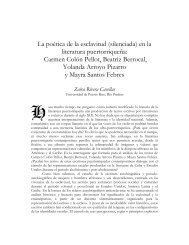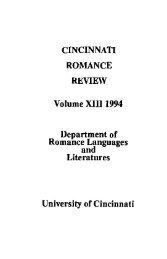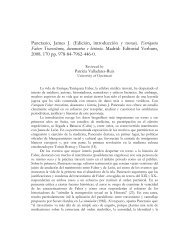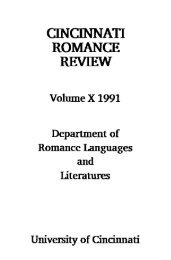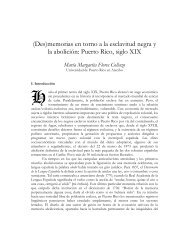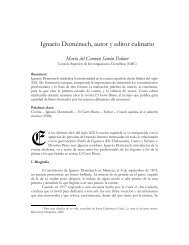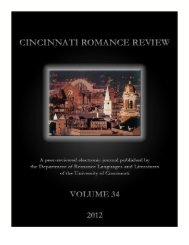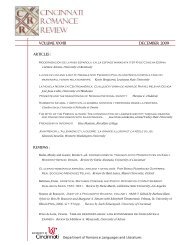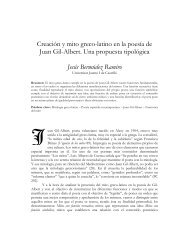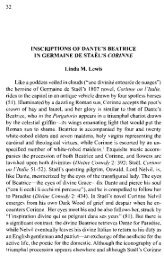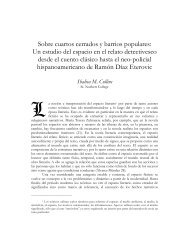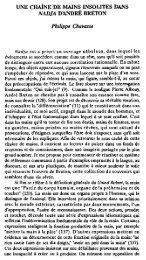Volume 30 (2011) - Cincinnati Romance Review
Volume 30 (2011) - Cincinnati Romance Review
Volume 30 (2011) - Cincinnati Romance Review
You also want an ePaper? Increase the reach of your titles
YUMPU automatically turns print PDFs into web optimized ePapers that Google loves.
174<br />
GALADRIEL MEHERA GERARDO<br />
of Mexico’s population was considered “black,” although a significant portion of the<br />
mixed-race population likely had some African heritage (Meyer 164-6).<br />
Prejudice against people of African descent had a long history in Mexico and<br />
Latin America in general, but gained new strength in the late 19 th century. In the period<br />
between 1880 and 19<strong>30</strong> an export dominated economy emerged and prevailed<br />
throughout Latin America. The regimes that corresponded with the lucrative export<br />
economies were responsive to the small population that controlled export money, and<br />
no longer had to give lip service to the concerns of common people, especially common<br />
people of color, in the way they had during the independence period (Andrews 118).<br />
Just as the Latin American elite exported raw materials en masse during this period, it<br />
also imported ideas from the North Atlantic countries that justified the subjugation of<br />
indigenous and African peoples in new ways. The pseudo-scientific racism in vogue in<br />
the United States and Europe came to dominate Latin American thought and policy in<br />
the second half of the 19 th century. In Mexico positivism, the belief “societies were<br />
evolving toward a final stage marked by a scientific outlook” (Trillo 1164), became<br />
particularly influential, and paired with pre-existing negative views of indigenous people<br />
and people of African descent served to further marginalize these two groups.<br />
In the late 19 th century Mexican intellectuals enthusiastically responded to the<br />
vogue of scientific racism in Europe and the United States. This treatise, most<br />
associated with Herbert Spencer and Social Darwinism, held that Anglo-Saxons<br />
dominated the globe, enjoyed the greatest prosperity, and had reached the highest level<br />
of technological, scientific, artistic, and philosophical “progress” because they were<br />
racially superior. Their very success and global domination was viewed as proof of their<br />
biologically determined supremacy. Poorer nations, colonial possessions, and<br />
“undeveloped” countries were depicted as weak as a result of their inferior racial<br />
makeup. Within this framework a complex racial hierarchy existed with northern and<br />
western Europeans at the top, followed by southern and eastern Europeans, West<br />
Asians, East and Southeast Asians, Native Americans, and people of African descent<br />
(although the exact order of the non-European groups sometimes changed depending<br />
on the so-called philosopher/scientist.)<br />
Late 19 th century Mexican intellectuals jealously regarded the seemingly<br />
homogenous populations of the United States and Europe. They associated their<br />
whiteness with modernity, and modernity with economic success and political power,<br />
and aspired to imitate the “modernization” and “progress” of these countries by<br />
whitening their own populations. Whitening and by extension modernizing their<br />
countries required bringing in more Europeans through immigration and diluting any<br />
pre-existing indigenous and African blood. Intellectuals across Latin America adopted<br />
Social Darwinism and scientific racism as weapons to fight the lagging progress of their<br />
nations (Andrews 118). In Mexico these intellectuals were known as científicos, and many<br />
were employed by the dictator Porfirio Diaz. Diaz’s científicos blamed Mexico’s problems<br />
on the supposed inferiority of indigenous people (Dawson 3<strong>30</strong>; Weise 753). Their ideas<br />
<strong>Cincinnati</strong> <strong>Romance</strong> <strong>Review</strong> <strong>30</strong> (Winter <strong>2011</strong>): 172-183.



